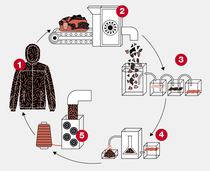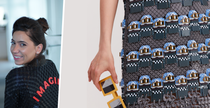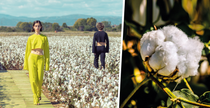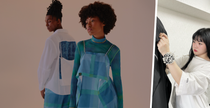“我们是在以操纵和剥削为基础的全球机制下的被动受害者。”
Carl Tillessen
消费主义专家

在阅读这篇文章时,你很大可能正穿着衣服——就像大约 17 万年前,人们一直在做的那样。起初,人们用树叶和毛皮遮挡身体。如今,服装就像我们的第二层皮肤。它显示了我们是谁,或者想成为谁。根据美国服装和鞋类协会的数据,仅在 2022 年,美国公民平均每人购买约 68 件衣服。这一数据与其他工业化国家的数据也很接近。但是,为什么我们有足够的衣服,却仍旧在继续购买呢?
“购物会激活我们大脑中的生物化学过程,类似于服用可卡因或坠入爱河引发的过程。”德国时装学院首席分析师 Carl Tillessen 解释道。他也是一本关于消费主义畅销书的作者。“我们是否需要这件物品完全无关紧要;重要的是购买时的感觉。“特别是时尚提供了一种便捷的方式,来满足我们表面上的需求,因为它以不断变化的趋势吸引着我们。”
虽然一套新衣服可以让你心情明朗,但服装的生产往往有不太光鲜的一面。时装业排放的二氧化碳占全球总排放量的10%,比国际航空和海上运输产生的排放的总和还要多。更不用说水污染和堆积如山的废旧纺织品,这都是廉价生产的“快时尚”不断推陈出新的结果。Tillessen 提醒我们多了解自己真正需要什么,以及我们服装是在怎样的工作条件下生产出来的。对于工人而言,这些条件往往是灾难性的,2013 年孟加拉国拉纳广场工厂倒塌等灾难就说明了这一点。“这只是低收入国家存在恶劣工作条件的众多可怕案例之一。在这些国家,尽管国家自身和国际社会作出许多努力,但童工现象仍很普遍。”
评估时尚购买的可持续性并不容易。可持续是一个多维度术语,包括环境、社会和经济因素。本文无法涵盖所有方面,但旨在提供信息和鼓励——因为现在已经出现很有前景的解决方案。创新的技术、替代的原材料和新的法规,正为降低时尚消费对环境的影响创造机会。而作为消费者,我们也具有影响力。让我们从纤维开始。
“我们是在以操纵和剥削为基础的全球机制下的被动受害者。”
Carl Tillessen
消费主义专家
预计到 2030 年,全球所有加工的纺织纤维中将有近四分之三是合成纤维,其中 85% 将是聚酯纤维。它重量轻,抗撕裂,干燥快——这无疑是一项出色的发明。但合成纤维,如聚酯、腈纶和尼龙,都不是可生物降解的,并会产生微塑料。根据艾伦·麦克阿瑟基金会(Ellen MacArthur Foundation)的数据,经过洗涤后,混纺的合成纤维每年释放出约五十万吨微纤维流入海洋。西班牙时尚集团 Zara Home 推出一种洗涤剂,可以在洗涤过程中减少最多 80% 的化纤衣物脱落。该产品特别适合用于低温洗涤,由巴斯夫和 Zara 母公司 Inditex 联合开发,现已在墨西哥和欧洲上市。它能保护纤维,延长纺织品的使用寿命,还能减少衣物洗涤对环境产生的影响。
如果你并不喜欢合成纤维,那么你的“第二层皮肤”可能由棉花制成,这是第二种最常用的纤维。但是,与合成纤维一样,棉花也并非完全无懈可击。有许多关于棉花种植园侵犯人权的报道,例如土库曼斯坦的强迫劳动。此外,种植棉花需要很多资源,从广阔的田地到大量的水。根据联合国的数据,制作一条牛仔裤需要 7500 升水,其中很大部分用于种植棉花。当然,也有另一种方法,使用可持续种植的棉花。我们稍后会回到这个问题。
用其他可再生原料制成的纤维可以更节约资源。例如,中国在大约六千年前就开始用麻来制成纺织品。这种作物的用水需求不高,与棉花相比,只需要一半的水,而纤维产量却高出 220%。然而,麻类仍然只是服装业的一种小众产品。首先,它比棉花更难加工。而且,由于麻类植物有“毒品植物”的名声,许多地方都禁止种植,因此农民往往对麻类植物并不熟悉。
在麻纺织品先驱的中国,情况却并非如此。中国目前生产全球 50% 以上的工业麻纺织品。除麻类植物外,许多替代的原材料也具有诱人的潜力。
但无论是涤纶、棉还是麻,所有纱线都需要上色。
Julian Ellis-Brown
"我们一直在寻找一种既能保暖,又不会对环境或动物造成伤害的材料"。
当Julian Ellis-Brown一开口,连英国国王查尔斯三世都听得津津有味。这位年轻的首席执行官兼初创公司 Ponda 的联合创始人在 2023 年夏天向英国国王展示了一件量身定制的分层式背心,并解释了其可持续填充物的好处,这位 "绿色国王 "听得津津有味。Ellis-Brown和他的三名同学在攻读创新和设计技术硕士课程期间,萌生了使用一种名为 BioPuff ® 的蓬松填充材料(羽绒的替代品)的想法。他们发现了蒲草,一种能够固碳和改良土壤的植物。他说:“推动我们想法的是设计一种能积极帮助拯救地球的产品。”在实验室里,四名学生开发出了一种从植物粗糙的球茎中提取柔软填充材料的方法。凭借这一创新想法,Ponda 获得了全球变化奖等荣誉。这位孜孜不倦的自然保护主义者还不到 30 岁,就已经开始与多家研究机构合作,研究下一种新型生物材料。
Ponda 生产有利于环境的材料。他们用湿地再生农业种植生产芦苇,用于替代鹅绒。
很难想象牛仔裤没有标志性的蓝色,或者夏日连衣裙没有大胆图饰。但是,色彩斑斓的服装是有代价的。
我们的祖先也喜欢色彩鲜艳的衣服,并使用自然界中发现的物质给纺织品染色。例如,来自Muricidae 家族的海蜗牛可以用来制作光芒四射的Tyrian紫色染料。但这种染料非常珍贵,只有当时的精英才能买到。还有靛蓝染料——一种从天然颜料中提炼出来的“蓝金”,可以为包裹埃及木乃伊的亚麻布条着色。如今,大多数情况下,我们使用合成染料给服装上色。染色过程中不仅需要大量的能源和化学品,还需要消耗大量的水。根据世界资源研究所(World Resources Institute)的数据,每年约有 5 万亿升水用于纺织品染色——足以填满 200 万个奥林匹克规格的游泳池。其后果之一是,根据联合国统计,全球约 20% 的工业水污染是染色和纺织品处理所导致的。染色厂未经处理的水被非法排入河流已是公开的秘密。
染色不仅会对环境造成负面影响,还会损害从业人员的健康。
另一个例子是是皮革的鞣制和着色,会使用铬盐、碱性溶液和染料。在低收入国家从事皮革加工的工人通常没有或只有基本的防护装备,他们会直接接触到这些物质——往往会对健康造成严重的后果。
对可持续替代品的探索意味着天然染料正在卷土重来。例如,瑞典初创公司 Mounid 开发出一种藻类染料。在使用喷雾技术应用这种藻类染料时,它比传统染色方法消耗的能源和水减少 90%。由于精细的雾化,染色通常更加精确,所需的染料也更少。与其他天然原料相比,微型藻类不会争夺耕地,还可以快速大量生产。但就目前而言,还不能按时装业所需的规模来生产替代的染料。
有一样东西非常容易买到,那就是旧衣服。接下来,让我们来探讨不再使用的衣服发生了什么,以及可能会发生什么。
巴斯夫为废旧纺织品闭环回收开发出创新解决方案
化学回收工艺可将旧锦纶衣物转化为 loopamid®,这是一种新型聚酰胺6 纤维的原料,可用于制造 100% 循环再生服装。
碎布被分解成其化学结构单元。
衣物分拣和破碎。
将单体重新转化为高纯度的聚酰胺 6,生产出新产品,即 loopamid®。
loopamid® is the starting material for new polyamide 6-fibers, which can be used to make new, 100 percent circular clothing.
由于材料中可能含有污染物和杂质,因此要进行清洁处理。产出:高纯度的化学结构单元(单体)。
“我们需要更多的循环经济。” 香港纺织及成衣研究所首席执行官 Edwin Keh 教授强调。“我们的服装通常由合成混纺纤维制成,很难被回收再利用。” 到目前为止,“纤维到纤维”的分类回收既复杂又昂贵。
虽然纤维的机械分离是一项技术成熟的工艺,但了解纤维和混合物的成分对是否能确保最优的回收再利用至关重要。然而,如果服装的标签有缺失、褪色或包含错误的产品信息,就很难做到这一点。这正是近红外(NIR)光谱可以提供帮助的地方。这种成熟的方法已经在塑料回收过程中的材料识别提供了支持,它利用近红外线使分子振动。这种振动因材料而异,由传感器检测到,并与数据库进行比较,因此几秒内就能得到纺织品类型的结果。巴斯夫子公司 trinamiX 已开发出一种基于近红外技术的便携式解决方案,用于按成分对纺织品废料进行分类,从而将不能再穿的服装在纺织品循环中得到回收再生。例如,总部位于德国的 Soex 集团采用这一解决方案,该集团是全球领先的废旧纺织品回收企业。
“我们需要更多的循环经济。”
Edwin Keh 教授,
香港纺织及成衣研究所首席执行官
化学回收可以将废旧塑料变成服装,从而使循环经济离我们更近。在化学回收的过程中,长长的塑料聚合物链会被分解成基本的组成部分。化学家 Izzy Manuel 表示:“这样做的好处是减少浪费,减少资源使用,减少污染。”她是“多巴胺穿搭”主义(通过服装搭配来营造愉悦感的穿搭风格)的引领者,也是在英国倡导可持续时尚具有影响力的人物。
可持续纤维和染料。这听起来不错,感觉也不错。但是,我们怎么知道这让人喜爱的新T恤是怎么制成的呢?
Danit Peleg
“想象一下这样一个世界,在这里,我们可以购买并下载服装的数字文件,在家里打印服装。”
Danit Peleg 的 3D 打印夹克上印有鲜红色的“想象”一词,它的创造者本人也闪烁着想象力的光芒。这位以色列人在特拉维夫的工作室里琢磨了数千小时,为时尚界带来了灵感。作为申卡尔工程与设计学院的毕业生,Peleg 是世界上第一个在家里使用标准 3D 打印机制作毕业系列作品的人,也是第一个在自己的线上商店出售此类服装的人。她说:“我喜欢尝试新的材料,并有兴趣突破打印技术和软件开发的界限,让时尚适合未来。” 这位 35 岁女性的愿景是,在未来,消费者将购买数字文件,使用价格低廉的 3D 打印机自行打印和定制个性化的服装。她说:“通过这样的方式就几乎没有浪费,供应链也将是循环的,而且这有望从本质上变得更清洁。英国广播公司(BBC)将Peleg选为2019年百大女性之一。
想象一下,你可以在家打印自己的衣服!
例如 Danit Peleg 等年轻设计师 正通过他们的 3D 打印系列,引领时尚走向未来。
自 2022 年起,#Seed2Sew 项目成为巴斯夫可持续纤维(CSF)认证棉花项目的一部分。巴斯夫在希腊开展的#Seed2Sew项目展示了如何在欧洲最大的棉花生产国实现这一目标。CSF促进棉花的可持续种植,能降低二氧化碳当量*排放,减少用水量,更精确地使用作物保护产品和肥料。此外,精心的土壤耕作、轮作、定期土壤分析和滴灌也保护土壤,节约水和能源。约有 1600 名农民、三家轧棉厂和一家纺纱厂参与了该计划,每年生产约 5 万至 5.5 万捆包棉花。
#Seed2Sew 目前还解决了从种子到零售的棉花供应链的透明度问题。巴斯夫区块链专家 Abhijeet Sharma 解释说:“我们正在利用区块链技术使棉花供应链更加透明和可追溯。”区块链是一种按时间顺序将数据储存在数字块中形成数据链的数据库。数据链存储在不同的联网计算机上,这些计算机相互监控。区块链被认为特别透明和安全,因为篡改很快就会被发现。农民通过区块链支持的手机应用程序记录他们的可持续种植活动。
这些数据与每捆包棉花上可扫描的二维码关联。Sharma说:“最后,成品服装也可以贴上二维码标签,这样就可以追踪从田间到最终消费者手中的每一个步骤。这个区块链项目 #Seed2Sew 共有五位农民、一位轧棉工和一位纺纱工以及生产合作伙伴参与。这相当于 315 公顷的棉花生产地,可以生产 2100 捆包皮棉,大约能生产 230 多万件 T 恤衫。
巴斯夫在美国也开展类似项目。e3®可持续棉花项目帮助棉农展示他们在可持续发展方面所作的努力,并为时装和纺织行业的品牌提供来源透明、可持续生产的棉花。
二维码并不是获取服装信息的唯一途径。纺织品标准也为我们提供线索。如果你查看衣服吊牌,是否看到认证标签?如果你发现标签上显示的是绿底白衬衫,那你买到的是可持续的衣服。全球有机纺织品标准(GOTS)认证是全球最严格的纺织品标准之一。它考量整个供应链中的环境和社会标准。另一个非常严格的环保标准是国际天然纺织品协会(IVN e.V.)的 IVN Best 认证。
IVN 涵盖从有机种植到最终产品的天然纤维供应链。但并非所有认证都如此全面。例如,Oeko-Tex® Standard 100 是世界上最著名的标签之一,但它只检测最终产品的有害物质,并不提供任何有关服装生产或环境影响的信息。因此,你一定要仔细检查衣服上的认证标签。但只有这些标准还不够。
在希腊科莫蒂尼附近的这片田地里,棉花占据中心位置。作为巴斯夫 CSF 项目的一部分,
这里的棉花是可持续生产的。从田间到商店,每一步都可以通过区块链进行追踪。
“We need government leadership to make the industry fairer by law,” says British social entrepreneur Safia Minney. What are governments around the world doing to make tailor-made fashion laws?
Many fashion companies have already recognized the need to act. One pioneer when it comes to sustainability is U.S. sportswear manufacturer Patagonia, which received the U.N.’s Champion of the Earth Award for its commitment. The company has been using recycled plastics since the 1990s, and launched a recycling program for its own clothing in 2005. In addition, it has established a social responsibility program for its supply chains. Many other producers have now done the same.
Advertising sustainable collections is now basically part of the standard repertoire of fashion labels. About 100 of these companies have signed the United Nations’ Fashion Industry Charter for Climate Action. As signatories, they commit to reducing their greenhouse gas emissions by 50 percent by 2030, as compared to 2019 levels. However, the environmental organization Stand.earth studied 10 of these companies and found that Levi Strauss & Co. was the only one likely to reach this target. “We need to bring about a cultural change among fashion companies and redesign the industry that it fits our planet and becomes fairer,” says Safia Minney. She is the founder of the ecological fashion label People Tree. It is considered the first label in the clothing industry with a completely sustainable supply chain, including strict certification – such as the GOTS seal.
“We need to bring about a cultural change among fashion companies.”
Safia Minney,
Founder of People Tree
The European Union wants to introduce a directive on corporate sustainability due diligence, which will apply to companies in all sectors, including the apparel industry. This law would oblige larger E.U.-based companies and foreign companies with a certain level of sales in the E.U. to protect human rights and the environment throughout their global supply chains. Moreover, the E.U. also wants to promote the circular economy. As a key component of its Green Deal, Brussels is about to adopt an Ecodesign regulation. The final discussions between the European Commission, Parliament and Council are under way. Among other things, this legislation would introduce an E.U.-wide ban on the destruction of brandnew textiles and shoes that are unsold or returned to the store. In general, its aim is to ensure clothing becomes more durable, easily recyclable and environmentally friendly by 2030.
Policymakers in other parts of the world are also taking action. In the United States, a new legislative proposal called the Fashion Act has been introduced in the state of New York. One goal of the law is to improve working conditions. At the same time, companies that want to sell their goods in New York state will be obligated to reduce their emissions in line with the Paris Agreement.
Jessica Chang
“Upcycling means to reuse materials that previously ended up as waste and give it a new life.”
Whether it’s unsold textiles or secondhand clothing, Jessica Chang gives it all a second chance. “Just as fashion trends are recycled, worn clothing can be too, so it doesn’t end up in the trash,” she says. The young designer grew up in Hong Kong and studied fashion design in New York. With her upcycling approach and reuse of textile waste, she is impressing the fashion world. Her collection “The Wall” won the Redress Design Award 2021, one of the world’s biggest competitions for sustainable design. The presented pieces are extra durable thanks to breathable openings, which ensure less sweating and less need to wash the clothes. Although Jessica has demonstrated the potential of discarded textiles, she herself avoids rejecting items wherever possible. “I am currently working on my fashion label PCES, which focuses on zero-waste patterns and recycled textiles to avoid any textile waste,” she says.
Designer Jessica Chang’s collections feature recycled textiles and zero-waste patterns.
“It’s the lifestyles of people in the North that are responsible for global warming, yet people in the Global South are bearing the brunt of climate and ecological collapse, and simultaneously fashion’s buying practices and trade terms are getting worse. We need to face into the responsibility that is calling all business leaders,” says Minney, who is also a founding member of the global network Fashion Declares. This is primarily concerned with “accelerating change in one of the most environmentally damaging and unfair sectors in the world,” says Minney. As well as publishing informational materials, the initiative offers regular webinars and launched the Regenerative Fashion Conference. “We need more transparency and collaboration among ourselves, we should share best practices and spark industry-wide debates,” the entrepreneur adds. Industry alliances face enormous challenges, as the example of the Partnership for Sustainable Textiles makes clear. It was initiated by the German government in 2014 in response to the Rana Plaza disaster. The Partnership advocates for a socially and environmentally responsible, corruption-free textile and garment industry. In the meantime, some members, such as the Clean Clothes Campaign, have left the initiative, saying the alliance has not improved working conditions in the global fashion supply chain.
Worldwide, policymakers and apparel brands have put sustainable fashion on their agenda. And many young designers have sustainability in their DNA. But to achieve sweeping changes in the industry, consumers will also have to do their part. “People buy more clothes and throw them away faster,” points out Professor Keh. Let’s look at how consumers can contribute.
Isn’t it annoying when jeans look great in the online shop but turn out to be too small, too big or just not right? Returning unwanted purchases is a hassle, and it causes packaging waste and transport-related CO2 emissions. A virtual changing room, such as the one offered by German online retailer Zalando, might help. A customer enters a few parameters into the app, such as their height and weight, to create a personal avatar that can enter the virtual fitting room. Even fashion shows are moving into the digital realm. Labels such as Dolce & Gabbana, Tommy Hilfiger and DKNY sent avatars onto the digital catwalk during Metaverse Fashion Week 2023. This saves fabric because the collections do not have to be physically produced for the show, and avoids CO2 emissions associated with transport and travel. Virtual fashion is nothing new in the gaming sector. Fortnite players, for instance, have long been able to purchase “skins” to deck out their avatars.
Quality over quantity: You can be welldressed with just a small wardrobe of high-quality basics (ideally with a textile certification). A “capsule wardrobe” contains pieces that can be combined with each other to make various outfits for every occasion. One of the first capsule wardrobe collections was released in 1985: US designer Donna Karan’s Seven Easy Pieces – seven items that could be mixed and matched. There are now many such collections on the market.
Getting a hole in one of your capsule basics does not have to mean it’s time to toss the item. Some clothing, such as pieces from U.K. firm WoolOvers, come with matching yarn and buttons to repair the garment. If you don’t have the skills or desire to fix it yourself, repair services are available. Online retailer Zalando, for example, started a pilot project called Care & Repair in 2021 and is now evaluating the program and its next steps. With this online service, customers were able to have their damaged clothing or shoes picked up at home and repaired by local businesses. By the way, in France, clothing repairs are now even subsidized by the government. Starting last October, anyone who takes their damaged apparel to a tailor or shoemaker is eligible to receive a repair bonus.
Or should your old coat be revived like the phoenix from the ashes? With its Renew program, U.S. fashion label Eileen Fisher offers a take-back service for items from its own collection. The clothing gets cleaned and partly upcycled. The company says that since 2009 it has taken back 1.9 million garments, which have been resold or transformed into new designs. This service does not only offer environmental benefits: Customers receive 5 U.S. dollars for each returned item of clothing – no matter what condition it is in. A similar approach is being followed by Swedish fashion label Asket. The company has opened a store in Stockholm, where it offers used and repaired Asket garments and is planning to host upcycling workshops for customers.
“The circular economy is beginning to shape clothing production, and on the consumption side, buying secondhand, rental and repair offer a way to reduce the ecological impact of fashion,” says Safia Minney, who has been buying secondhand fashion and trading clothes since she was 17. Meanwhile, her nieces benefit from the clothes she no longer wears. For those who don’t have an aunt who is a fashion designer: Online platforms such as Rent the Runway offer designer clothing and accessories for rent. More than 140,000 people currently use the U.S. firm’s clothing subscription service. “In our society, we are used to buying lots of clothes on a monthly, weekly or even daily basis. It can be hard to break that habit. To do so, before I make a purchase, I ask myself: Will I really wear this? Am I buying it just because it’s a bargain or because I’m in a buying mood right now?” The maxim when it comes to your own wardrobe should be: Slow down! Be intentional and inform yourself before buying something new. Buy fewer items but carefully chosen ones of good (recycled) quality. And, wherever possible, trade or upcycle. Our clothing choices determine how much responsibility we take on for people and our planet.









